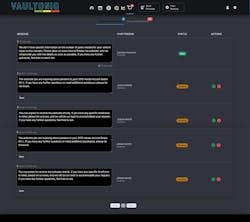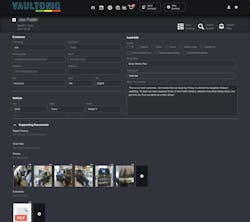It is said that a tool is only as good as the hands using it — but it could also be said that it is only as good as its suitability to the task it’s needed for. The world’s finest hammer won’t help you change a lightbulb. When it comes to software tools in the body shop, you’ll find a myriad of tools designed to improve a myriad of processes within a shop, but what if there was one tool that could take some of those tasks over completely, or at least make them a much lighter lift for your staff?
Tom Zoebelein, principal of the automotive repair marketing agency Stratosphere Studio, sought to create a tool in the same vein as BodyShop Booster, something that could automate or lessen the workload in a shop with a laser focus on improving one thing: profit. That product is called Vaultoniq, and it uses a very modern solution to eliminate wasted time, gaps in scheduling, and, ultimately, profit loss: the power of AI.
“It’s looking at the whole shop and organizing everything in a shop, like it’s back and forth, communicating with everything. So, it’s kind of like running production and front office tasks,” says Zoebelein. “…It’ll learn over time. It’ll get better over time. But it’ll work day-one right out of the box.”
as told to Todd Kortemeier
This started through my marketing agency. Over the years, I just kept showing it to shops and asking, what does it need? And it sort of turned into a management system, but that’s not how we’re positioning it. You could maybe replace management software to a degree with this, but that’s not what we’re focusing on; what we’re focusing on is generating more profit for shops.
It’ll help shops win more lines on an estimate by using AI to craft responses to the insurance companies. It has an AI production scheduler that will study the efficiency of all the technicians, and it’ll generate a dynamic schedule that can change as things change in the shop, and it’ll predict when every car is going to leave the system. It’ll auto-update customers, auto-communicate with insurance adjusters, and save hours in the front office.
Improving communication
I did a quick study one day. I grabbed one of my marketing agency clients, and I just timed myself how long it took to just recreate all the texting back and forth between a customer and insurance company and the shop, and it averaged 45 minutes per customer. So, if you’re doing 50 cars a month, that saves five days of just typing, let alone the time to go find the answers and everything — literally just the typing of it.
You can communicate with the customers and the insurance adjusters all in one platform. It uses a single inbox concept where the estimator’s not talking with the insurance company from his email or on his cell phone, and the front office isn’t emailing out of their email address. It’s all coming out of the system, and this has all the process steps. You can text and email the customer or the insurance adjuster, and we have AI tools to help do that. If we want to write a message to a customer, we can use AI assist and put a prompt in here like, “Inform the customer the car is ready,” and hit “generate” and it’ll write the message to the customer. You can tell it to be sympathetic and apologize if communicating a delay.
The AI knows everything about this customer record. Anything a customer records, it can search. It’ll go through the text messages and emails. Say the customer needs the car back by Friday to attend his daughter’s wedding. It can read all this and be searchable and answer questions.
Filling scheduling gaps
With each customer record, you can attach any supporting documents — your photos, your estimates, your videos, your OEM procedures, authorizations, measurements, anything related to this customer. When you move this record into production, it automatically schedules it, knowing whether it’s a drive, non-drive, severity, if there are parts waiting, etc. It schedules it to a tech and blocks out that tech’s schedule for the appropriate number of hours for that job. You can see how much capacity is in the shop.
The technicians have the software in an app on their phone. They can clock in each day, check their schedule, etc. And once they start working on a car, they start the clock. As they’re working, they can add photos, documents, go through checklists, and then when they stop the clock, that completes the phase. It’ll auto-generate a message to the customer, move the car to the next phase, and update the production board.
The next frontier
We have a tool in development called Defender which can take an estimate and the insurance company’s rejection to you, like, “We’re not going to pay for this or that.” And then it’ll crawl through the necessary materials, whether that’s the OEM procedures or like any kind of documentation backup that a human would normally go through and look at. It’ll crawl through that because it’s agentic. So, it’s an agent that knows how to log in and knows how to read through stuff. It can read images, it can read text and craft a response that you then copy and send back to the insurance company. We hope to have a prototype of that tool soon.
There are a few AI tools that are out there right now, but ours is the only one that is using AI as like a whole-shop solution. First customer interaction, fighting with the insurance companies, predicting your revenues, and scheduling all the vehicles, to me, the heart of it is the schedule, because we have an AI schedule that knows all these things and can change on a whim. And changes happen in the shop. It can pull all the other levers automatically using AI. So ours is like a whole shop AI solution to eliminate time everywhere.
About the Author
Todd Kortemeier
Todd Kortemeier is former editor of FenderBender magazine and started writing as a contributor in 2024.



